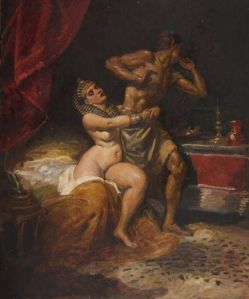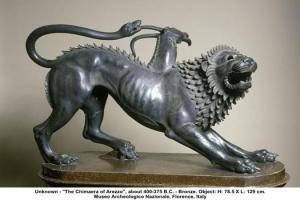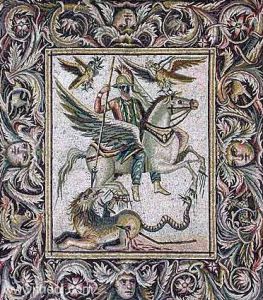The original Chimera is a creature from Greco Roman mythology which has the head of a lion, the head (or body) of a goat, and the tail of a serpent (often represented with a serpent’s head). The earliest reference we have is from the Iliad by Homer. Shown below is an intriguing Etruscan bronze, the Chimera of Arezzo, from the 4th Century, A. D.
Going back even further, there is this Greco Roman mosaic from Palmyra, 3rd Century, A. D. It depicts the battle in which Bellerophon slays the Chimera while riding on Pegasus, the winged horse which he tamed with the help of the goddess, Athena.
As is often the case in mythology, it all started with a woman. Bellerophon resists the efforts of Sthenoboea, the wife of King Proteus, to seduce him. Angry at being jilted, she levels accusations against him. This is reminiscent of the tale of Joseph resisting the efforts of Potiphar’s wife to seduce him. The latter is found in the book of Genesis from the Old Testament and is, incidentally, the older account.

Anyway, King Iobates of Lycia, the father of Sthenoboea, assigns Bellerophon a number of heroic tasks, including the slaying of the Chimera. Athena gives our hero a golden bridle which will enable him to mount and ride Pegasus. In this next painting, Athena can be seen standing in the background.

I will end this post with another depiction of the ensuing battle.



Thought you might enjoy this: https://mail.google.com/mail/u/0/?hl=en&shva=1#inbox/159105385d5ebac5
LikeLiked by 2 people
Thank you, sir, and a happy holiday season to you.
LikeLiked by 1 person
Man so many kinds of mythical beasts…
LikeLiked by 2 people
Kind of makes you wonder why they (whoever they are) thought these creatures up.
LikeLiked by 2 people
Yeah!
LikeLiked by 2 people
Yeah… Sometimes when you look at these traditional beasties of mythology, you wonder… Who thought this critter would be scary?
LikeLiked by 2 people
I’ve always wondered who first had the idea of combining body parts from different species.
LikeLiked by 2 people
When I was a child, the Catholic school I attended sometimes forbade me from signing out the book – Pegasus, The Winged Stallion, as retold by Nathaniel Hawthorn. I signed this book out every week, from first to sixth grade-no kidding. I’ve since found this cherished book through diligent research on the Library of Congress’s website. We’re reunited once again. This book might just be my very first real love:)
am:)
LikeLiked by 2 people
That’s a neat story. I think one for me would have to be a paraphrased account of Beowulf wrestling Grendel that I read as a boy. As an adult, I bought a good, scholarly translation of the entire poem. I loved it and have read it three times. Each time I got more out of it. It’s an excellent work of poetry.
LikeLiked by 2 people
😊
LikeLiked by 2 people
Did you ever hear the theory that some of the mythological beasts were the result of the ancients coming upon dinosaur, mammoth and mastodon fossils and then imagining the appearance of the creature that left such strange, colossal, enigmatic remains?
LikeLiked by 1 person
Yes, but in connection with dragons and dinosaurs. Concerning these others, chimeric forms appear in Greco Roman mythology as well as the Bible. That brings up the additional theory that mankind has had spiritual experiences or visitations in the past and that some of these renderings are distorted versions produced after generations of unfamiliarity. I have also heard that the creatures in the Biblical accounts had symbolic significance. This is an interesting topic.
LikeLike
Yeah, I’m pretty sure the Biblical ones were mostly symbolic in nature. Good points.
LikeLiked by 1 person